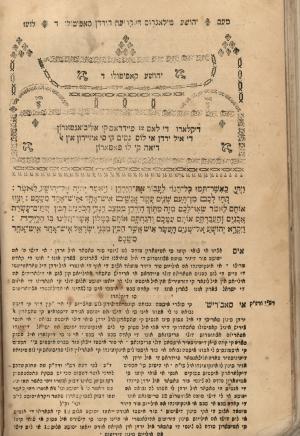Obj. ID: 38793
Jewish printed books Me'am Lo'ez Yehoshua' 1 by Rachamim Menachem Metrani, Thessaloniki (Salonika), 1851

This text was prepared by William Gross:
Me'am Lo'ez (Hebrew: מעם לועז), initiated by Rabbi Yaakov Culi in 1730, is a widely studied commentary on the Tanakh written in Ladino - it is perhaps the best known publication in that language. In Rabbi Culi's time, many individuals in Turkey were not sufficiently fluent in the Hebrew language to study the Torah and its commentaries in the original. Rabbi Culi thus undertook the "colossal task" of writing a compendium of the major fields of Torah study. The commentary was to be user-friendly and was thus written in Ladino or Judaeo-Spanish, the Jewish language spoken by the Jews in Turkey.
The book was divided according to the weekly Torah portion (Parashat hashevua); Rabbi Culi explains each chapter in detail according to the Midrash and Talmud, as well as discussing the relevant Halacha as based on the Shulchan Aruch and Mishneh Torah. In his introduction Rabbi Culi personally guarantees that "everyone who reads the Me'am Loez every day will be able to answer in Heaven that he has learned the whole Torah, because all aspects of the Torah are covered on it".
While Rabbi Culi died only two years later after completing the Book of Genesis and 2/3 of Exodus, due to its mass popularity - and the extensive notes already written by Rabbi Culi - a decision was taken to complete the commentaries. Rabbi Yitzhak Magriso completed Exodus, and wrote the commentary on the books of Leviticus and Numbers. Deuteronomy was done by Rabbi Yitzhak Bechor Agruiti. The commentary on Joshua was written by Rabbi Rachamim Menachem Mitrani. The Book of Esther was done by Rabbi Raphael Chiyya Pontremoli. Rabbi Shmeul Yerushalmi translated the works into Hebrew, although greatly deviated from the originals on their Nach commentaries and the book of Avoth. He also continued the Meam Loez work in Hebrew on many of the books of Nach that the sages before him did not write.
The Me'am Loez quickly became extremely popular in the Jewish communities of Turkey, Spain, Morocco and Egypt. With the decline of Ladino after the Holocaust, various translations were produced, and the work can still be found in many Orthodox synagogues to this day. In 1967, a Hebrew translation, Yalkut Me'am Lo'ez, was produced by Rabbi Shmuel Kravitzer. The first English translation, the Torah Anthology, was written (primarily) by Rabbi Aryeh Kaplan; this translation has introduced Me'am Lo'ez to the Ashkenazi world. (In 1964, Gonzalo Maeso and Pascual Recuero, two Catholic scholars, from the University of Granada produced a modern Spanish printing. "Apparently, their lack of knowledge regarding both Turkish and Ladino resulted in an edition filled with inaccuracies".) Pilar Romeu published in Barcelona, 2000, a critical edition with concordance and analytical indexes of the Me'am Lo'ez of the Pentateuch (Torah). Another Spanish scholar, Rosa Asenjo, published in Barcelona, 2003, the Me'am Lo'ez of Song of Songs (Šir ha-širim) of Hayim Y. Šakí (Constantinople, 1899)
This book is the only edition of Me'am Le'oz for the Book of Joshua.
The history of Hebrew printing in Salonica began in the early 16th and lasted some 400 years, being brought to an end only with the Nazi conquest. The first Hebrew press was established in Salonica in 1512 by a Portuguese printer and émigré, Ibn Gedalya. By the 1560’s, with the mass influx of former Marranos from the Iberian Peninsula, printing activity in Salonica reached its height, with more than 120 books published (including a few in Ladino). With the exception of a short period, however, the city did not have any well-established printing house until the end of the 17th century.
By the mid-18th century, several printing houses which were to enjoy long periods of activity had been founded. In addition to the larger, more well-known printing houses in this period, there were also smaller establishments that were active for brief periods only, and generally printed Torah-related works. Among these is the printing house of Daniel Faraji, whose was active c.1842-1851.





